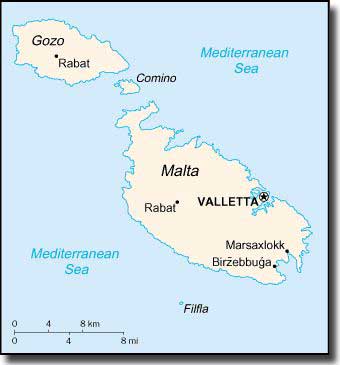The Battle for Malta. Six Vital Months - Spring and Summer 1942
The tiny island of Malta, only 316 square kilometres, no bigger than the Isle of Wight off England's south coast, sits in the middle of the Mediterranean Sea, with two smaller islands Gozo and Comino. During WW2, its strategic importance and retention played a vital role, being the key to the final Allied victory in North Africa.
One quote from the distinguished Australian War Correspondent Alan Moorhead will suffice to illustrate the agony this island endured for the Allied cause.
"The greatest of battles for supply fell upon Malta. This was now turned into a hell. Malta was a base for British submarines and aircraft preying on Axis lines of supply to Libya. In the spring of 1942, the Axis decided to obliterate that base and they wanted to starve it as well. Right through the spring they turned such blitz upon Malta as no other island or city had seen in the war. It was a siege of annihilation. One after another all the great sieges were eclipsed - England and Odessa, Sebastopol and Tobruk. Malta became the most bombed place on earth."
Malta has a long and varied history, a Phoenician colony about 1,000 BC, then occupied by the Greeks in 746 BC, to be possessed by Cartage and Rome. Along came the Arabs in 870 AD, to be followed in 1,090 by the Normans taking control, and later to be a fuedal fiefdom of Sicily. The Roman Emperor CharlesV granted Malta to the Knights of St John of Jerusalem in 1530, they ruled into the 19th. century, making Valetta one of the Mediterranean's greatest strongholds.
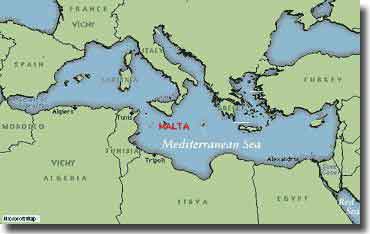
The strategic significance of Malta may be seen from this map of the area
Britain acquired the island in 1814, until it gained its independence on the 21st. of September in 1964, but remaining within the Commonwealth, to become a Republic ten years later.
The Air Officer Commanding Malta had been bombarding his Air Ministry in London and his Command Head Quarters in Cairo about his plight both in aircraft type and availability of pilots, all of whom were tired and at the end of their rope.
Spitfire V sent to defend Malta
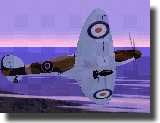 |
Air Marshall Tedder at Cairo sent off Group Captain Basil Embry to Malta to appraise the situation there, he soon summed up the desperate position, making out a trenchant case for the Island to be quickly supplied with SpitfireV and Kittyhawk fighter aircraft, and a batch of fresh pilots to fly them.
Action was soon forthcoming, 15 pilots to be despatched from England by a Sunderland flying boat, with another 15 pilots to soon follow them. Spitfires were flown into Malta from the carrier HMS Eagle on the 7th. of March 1942. Royal Navy submarines and RAF/ Fleet Airarm torpedo carrying aircraft out of Malta were wreaking havoc on Axis shipping carrying supplies and reinforcements to the German/Italian forces in North Africa.
The German Command decided to invade Malta to rid themselves of this menace once and for all, Operation Herkules was to be mounted in the spring, but first of all the island defences had to be wiped out. That task fell to both the Luftwaffe and the Italian Regina Aeronautica.
The bombing of the tiny fortress was intense, of the 6,728 tons of bombs to fall on Malta in April, 3,156 tons were dumped on the harbour at Valetta.
More Spitfires arrive at Malta.
Squadrons 601 and 603 manning new Spitfires arrived to help a desperate situation on the 20th. of April, then the US carrier Wasp, and HMS Eagle with 46 and 13 more Spitfires respectively, helped turn the tide in just a few days, the Luftwaffe lost about 500 aircraft, either destroyed or badly damaged during those trying days.
King George VI grants George Cross to the people of Malta.
In a gesture designed to both recognize the agony sustained by the Island of Malta and its population, and to lift the people's spirits, King George the VI th. awarded a George Cross Medal to Malta: "To bear witness to the heroism and devotion of its people during the great siege it underwent in the early parts of World War Two."
Malta Government strikes a Medal to commemmorate the 50th. Anniversary of award of George Cross.
In 1992, to dignify the 50th. anniversary of the presentation of the George Cross to the Island, the Malta Government struck the "Malta George Cross Fiftieth Anniversary Commemmorative Medal." for service between the dates of the 10th. of June 1940 to the 8th. of September 1943, on the island or in ships supporting it.
The ribbon, two narrow stripes of white and red on a blue background, are to represent the Malta Flag and the George Cross. The closing date to apply for this medal was set at the 15th. of April in 1994.
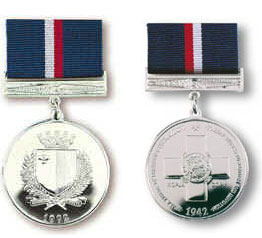
Maltese George Cross Fiftieth Anniversary Commemmorative Medal, Obverse side, struck by Maltese Government in 1992, for the 50th. Anniversary of the presentation by King George the VIth. of the George Cross to the people of Malta. I was awarded this medal by the President of Malta for service in HMAS Australia in 1940, we were part of a Naval force supporting a Malta Convoy.
Attempt to starve Malta into submission.
With the arrival of the extra Spitfires, Malta was able to hang on, now the Axis tried to starve the Island into submission by destroying the convoys supplying it. July/ August 1942 were awful months, and by the end of August fuel and ammunition were almost exhausted, it was a desperate, desperate time.
Operation Pedestal.
In August 1942, Malta was on its last legs for food, fuel and ammunition, without relief it would soon have to surrender. The dockyards here had been pulverised out of operation, and Malta virtually neutralised. Winston Churchill was well aware of the strategic importance Malta to the success of the Allied armies in North Africa, and to opening up of an invasion into Southern Europe through Sicily and then Italy. He ordered Operation Pedestal to be mounted, a convoy of 14 merchant ships including the US tanker Ohio, supported by a huge Naval Escort, in an attempt to break the blockade of Malta, and bring succour to the beleagured Island and its people.
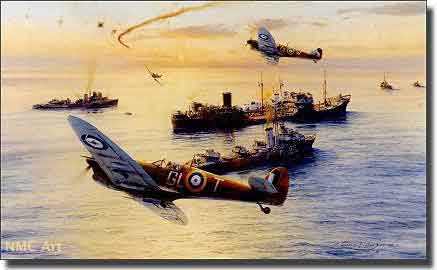
Painting by Robert Taylor of the gallant Ohio
The convoy passed through the Straits of Gibraltar into the Mediterranean on the 10th. of August, for three days and three nights it was harried by both German U-Boats and Italian Submarines, E-Boats, dive and torpedo bombers, high level bombers.
This convoy was subjected to the most ferocious and heaviest bombing attacks endured by any convoy in WW2. A number of the Naval Escorts were sunk, and only 5 of the merchant fleet remained afloat, a bomb had struck Ohio in her engine room, and two enemy aircraft had crashed on board, but her crew had put out the resultant fires, she was afloat but only just. 60 miles still to go to reach Malta, Ohio was dead in the water, three British destroyers were secured to her, HMS Bramham port side, HMS Penn starboard side, and HMS Ledbury at her stern. They then nursed the stricken tanker into Valetta Harbour to arrive on the 15th. of August, to the cheering crowds gathered around the seafront to welcome them.
Malta was relieved to at last survive, General Montgomery went on to win his famous Battle of El Alamein.
September in contrast to August was almost calm, but then in October the fighting again erupted on the 10th. of that month, but Malta, its Spitfires, and their pilots all stood firm, and the Island was saved.
It had been a very close run thing, but in the end, the toughness of the people hanging on when all seemed lost, and the few aircraft and the men who flew them prevailed against seemingly impossibe odds.
Malta and its people had indeed earned their GEORGE CROSS.
See this article in the Clarion University Newswire,
January 24, 2003, "American
lecturer to write war book about Malta"
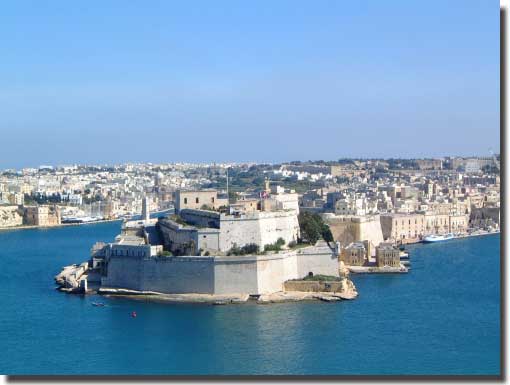
View of Malta and the Grand Harbour
See this
article in the Clarion University Newswire, January 24, 2003, "American
lecturer to write war book about Malta"
47 page description written by one of the Spitfire pilots involved
I believe this is a unique piece of history, probably it had a limited distribution at the time it was written over 60 years ago, and we indeed are fortunate that Paul has found AHOY and shared a copy with us. Malta was vital in the Mediterranean at this time, if we were to be victorious in North Africa, it was the island base that supplied our Armies there, and the Axis powers did their utmost to knock out Malta. It was rather like the necessity to retain Guadalcanal in the Pacific war, to safeguard the lifeline from the US to Australia, and then be a springboard in our northward advance.
Good Morning Mac or evening from your point of view.
Here's the Acrobat file. I looked at it and it looks OK. If anything is missing or illegible, please let me know and I'll try to fill. History, like everything else, is a giant jigsaw puzzle. Hopefully, I've been able to add a piece. I don't know if this has ever been formally published, either by itself, or as part of a larger work. For it's size, Malta has enjoyed an out-sized role in the history of the Mediterranean area and control of it has been coveted by many since man first set sail on the sea. I hope you enjoy this. I certainly did.
Click here to read the whole document. An excerpt:
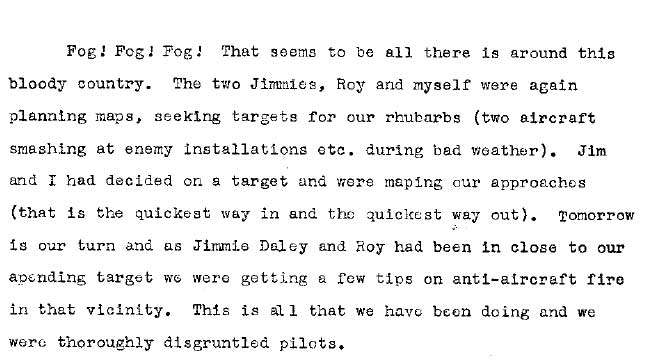
Cheers!
Paul
Here is some detail of Flight Lieutenant Edward Jumbo Gracie CO of the Spitfire group in your manuscript. He went on to become a Wing Commander, but died flying a Mosquito on the15th. of February 1944.
F/Lt Edward J. 'Jumbo' Gracie flew with No 56 Squadron during the Battle. On the 10th of July 1940 his Hurricane was damaged in combat with some Bf 110's and he crash landed with a seized engine at Manston. He destroyed four enemy aircraft before the 8th of August 1940, and a further three before the 30th of August 1940. On the 30th of August 1940 he destroyed a Heinkel He 111 but was himself shot down at 16:45hrs, crash-landing his Hurricane I (R2689). He thought himself unhurt but next day discovered he had a broken neck, requiring admission to hospital! Gracie was awarded the D.F.C. on the 1st of October 1940. He scored six more kills flying from Malta. E.J.Gracie later flew Mosquito's on night escort for R.A.F. heavy bombers. E.J.Gracie was K.I.A. on the 15th of February 1944, aged 32.
Squadrons 601 and 126 served on Malta. (See "Squadron 126 leader ARH Barton - Tony or Killer" July 14, 2012)
This account may well relate to 126 Squadron.
I think the author was an American, he uses words such as state room, and gotten, not normally used by British, Irish or Australians, he also notes Jimmie and I had just left the Eagle Squadron, formed essentially from Americans who joined the RAF early in WW2.

